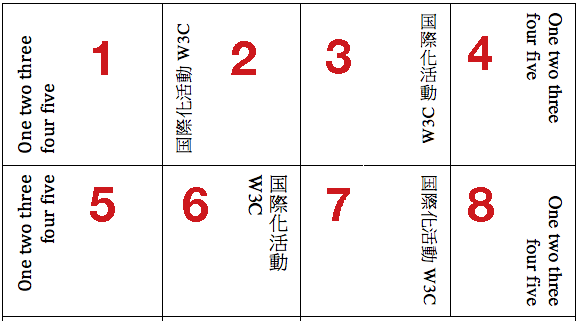- From: Richard Ishida <ishida@w3.org>
- Date: Mon, 13 Jul 2015 09:57:04 +0100
- To: Koji Ishii <kojiishi@gmail.com>
- CC: fantasai <fantasai.lists@inkedblade.net>, "www-style@w3.org" <www-style@w3.org>
- Message-ID: <55A37D60.50209@w3.org>
On 12/07/2015 06:57, Koji Ishii wrote:
> On Sat, Jul 11, 2015 at 12:21 AM, Richard Ishida <ishida@w3.org
> <mailto:ishida@w3.org>> wrote:
>
> [snip]
> i have attached an image that shows various numbered use cases.
> Fantasai, Koji, Florian, could you each indicate how you think CSS
> properties and values should be used to achieve each of the use cases?
>
>
> 1, 2, 5: sideways-lr, non-CJKM
> 3, 6: vertical-rl, CJK
> 4, 7, 8: sideways-rl, non-CJKM
>
> vertical-lr (Mongolian) is not included in these 8 cases. They look
> similar to 3, 6 but lines flow from left to right.
this misses a key thing i was looking for, which is where the line start
is, and how the text is aligned.
from the rest of your email, i conclude that the following applies. Is
this correct?
[1,2] writing-mode: sideways-lr;
[5] writing-mode: sideways-lr; text-align: end;
[4] writing-mode: sideways-rl;
[7,8] writing-mode: sideways-rl; text-align: end;
[6] writing-mode: vertical-rl;
for [3] see below
> what's the difference between sideways-rl and vertical-rl?
> Presumably none for horizontal latin text.
>
>
> Almost none. but two I would list are:
> 1. Ambiguous (unified) characters behave as CJKM for "vertical" and as
> non-CJKM for "sideways".
> 2. There are some subtle typographic differences between Latin
> characters in CJK vertical and rotated Latin. They're distinguished
> between the two values.
>
> Or does this rotate all CJKM characters 90º clockwise?
>
>
> Yes for "sideways", no for "vertical". You could consider "sideways"
> being no more than rotation, while "vertical" involves CJKM vertical
> flow typographic conventions such as their native characters appear in
> upright.
...
> I think you're trying to understand in a complex way. Is it easier to
> understand if you consider "sideways-rl" is a clock-wise rotation, and
> "sideways-lr" is a counter-clock-wise rotation? It's what they do.
i think the key to clarity here is to indicate *what* it's a clockwise
rotation of: characters or lines? As i understand it, it a clockwise
rotation of lines (or sometimes parts of a line).
that makes sense. So effectively, writing-mode determines the
orientation of lines, with the caveat that if you use vertical-xx, it
also factors in an upright rotation of certain characters so that CJK
look upright and Mongolian looks right too.
that seems ok to me.
...
> I think opposite. The important distinction is whether you want to
> rotate "characters" or "lines". With the proposal, if you want to rotate
> "lines", writing-mode is the property, it now allows both 90 and 270. If
> you want to rotate "characters" without affecting lines at all,
> text-orientation is the property. The current sideways-left and
> sideways-right are not consistent in this regard.
>
...
>
> Yeah, that's where this proposal improves. Now you can use the same
> property to rotate clock-wise or counter-clock-wise, just different
> values. Non-CJK authors have no question in character orientation once
> line was rotated, so all they need to learn is the writing-mode property.
>
> fwiw, here's an example of Latin text running up the page, however
> it is only in a loose association with the vertical-rl orientation
> of the chinese and japanese alongside it. I can count on one hand
> the other examples i've seen of text running in this direction. I
> assume that if this were translated into Arabic, that would run down
> the page but with the top of the glyphs to the left.
>
> https://www.flickr.com/photos/ishida/19391039009/
>
>
> This example in the current spec is:
> writing-mode: vertical-rl; /* rotate lines (along with characters) 90
> degree */
> text-orientation: sideways-left; /* then rotate lines (along with
> characters) 180 degree */
> With this proposal:
> writing-mode: sideways-lr; /* rotate liens (along with characters)
> 270 degree */
the new proposal seems more straightforward to me.
[Actually, the setting of the top of the three boxes containing text is
set at a regular offset from one line to the next, which makes me think
this is 3 separate boxes with text aligned towards the top of the page.
So with this proposal, i think you'd have to have
writing-mode: sideways-lr; text-align: end;
set on the box containing Latin.]
if, however, the text was embedded inline and ran up the page - which is
what [3] in the original image should have shown, if i hadn't forgotten
to fix it, and what [3] now shows in the attached, updated image – i'm
assuming that the current proposal would require you to do something
like add a span around the latin text and apply CSS per
span.latin { writing-modes: sideways-rl; }
assuming that that's correct, if we add span.latin { margin-start: 10px;
}, does the space open up above or below the latin text? If, however, we
add span.latin { ruby-align: start; } and the rt says 'a', i assume that
the 'a' would appear over 'W' in W3C. Is that right?
ri
Attachments
- image/png attachment: vertical-test-cases-2.png

Received on Monday, 13 July 2015 08:57:18 UTC